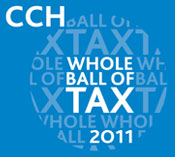| Home | About Us | Order Products | Press Center | Customer Service | Career Opportunities |

CCH can assist you with stories, including interviews with CCH subject experts.
Also, the 2011 CCH provides special CCH Tax Briefings on key topics at CCHGroup.com/Legislation.
|
Retirement by the Numbers: Employer Plans, IRAs and the Saver's CreditNo COLA Means Little Changes in Contribution Amounts for Most 2011 Retirement VehiclesBoth IRA contribution levels and contribution limits to employer-sponsored programs are subject to cost of living adjustments (COLAs). However, with no COLA change, the contributions remain the same for 2010 and 2011. Allowable adjusted gross income parameters for traditional deductible IRAs for married couples filing jointly and for taxpayers making Roth IRA contributions will rise for 2011. Changes also are made to 2011 income thresholds under the Saver’s Credit, which is a nonrefundable tax credit that allows lower- and middle-income retirement plan participants to use elective contributions to reduce their federal income tax on a dollar-for-dollar basis.
* Subject to COLAs. ** SARSEPs must have been established prior to January 1, 1997. The maximum contribution and catch-up amounts are the same as for 401(k), 457 and 403(b) plans. *** Individuals have until April 18, 2011, to make contributions to their IRAs for 2010.
**** Depending on AGI, the credit ranges from 10% to 50% with lower income taxpayers being eligible for a higher credit. For example, a married taxpayer filing jointly with an AGI of $34,000 or less making a $2,000 retirement plan contribution in 2011 could be eligible for a 50% credit, or $1,000. By contrast, if that same taxpayer had an AGI between $34,001 and $36,500, she would be eligible for a 20% credit, or $400; an AGI between $36,501 and $56,500 would make that same taxpayer eligible for a 10% credit, or $200. SOURCE: CCH, 2011 Permission for use granted. nb-11-27
|
||||||||||||||||||||||||||||||||||||||||||||||||||||||
© 2024, CCH INCORPORATED. All rights reserved. |
Back to Top | Print this Page | ||||||||||||||||||